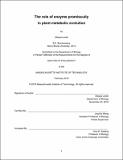| dc.contributor.advisor | Jing-Ke Weng. | en_US |
| dc.contributor.author | Levsh, Olesya. | en_US |
| dc.contributor.other | Massachusetts Institute of Technology. Department of Biology. | en_US |
| dc.date.accessioned | 2019-10-11T20:30:01Z | |
| dc.date.available | 2019-10-11T20:30:01Z | |
| dc.date.copyright | 2018 | en_US |
| dc.date.issued | 2019 | en_US |
| dc.description | This electronic version was submitted by the student author. The certified thesis is available in the Institute Archives and Special Collections. | en_US |
| dc.description | Thesis: Ph. D., Massachusetts Institute of Technology, Department of Biology, 2019 | en_US |
| dc.description | "February 2019." Cataloged from student-submitted PDF version of thesis. Vita. | en_US |
| dc.description | Includes bibliographical references. | en_US |
| dc.description.abstract | Metabolic expansion was a key event facilitating the transition of early plants from aquatic to terrestrial environments and their subsequent radiation on land. The breadth and diversity of plant specialized metabolism reflects upon the adaptive innovations that took place during plants' colonization of land in the past 500 million years. Moreover, these rich metabolic networks are valued for the array of bioactive molecules they encompass, many of which have industrial and pharmaceutical applications. Studies of plant specialized metabolic pathways reveal that most of these arose as extensions of pre-existing enzymes and metabolites, leveraging promiscuous enzymatic activities and opportunistic gene duplication events to produce novel metabolic traits. The goal of this dissertation is to examine the mechanisms of enzyme promiscuity with regard to the expansion of plant specialized metabolism. First, we probed the structural and dynamic bases of substrate promiscuity hydroxycinnamoyltransferase (HCT), a member of the BAHD acyltransferase family, which has contributed significantly to the diversification of specialized metabolism throughout land plant evolution. We subsequently generated an Arabidopsis thaliana line containing a loss-of-function hct mutation and demonstrated that the mutant phenotype can be complemented with orthologous HCTs in order to establish an in vivo system to study promiscuity. Finally, we characterized a case of independent emergence of rosmarinic acid biosynthesis, a specialized metabolic trait, in the closely related Boraginaceae and Lamiaceae plant families. Collectively, our findings contribute to a mechanistic understanding of the role of enzyme promiscuity in plant metabolic evolution. | en_US |
| dc.description.statementofresponsibility | by Olesya Levsh. | en_US |
| dc.format.extent | 156 pages | en_US |
| dc.language.iso | eng | en_US |
| dc.publisher | Massachusetts Institute of Technology | en_US |
| dc.rights | MIT theses are protected by copyright. They may be viewed, downloaded, or printed from this source but further reproduction or distribution in any format is prohibited without written permission. | en_US |
| dc.rights.uri | http://dspace.mit.edu/handle/1721.1/7582 | en_US |
| dc.subject | Biology. | en_US |
| dc.title | The role of enzyme promiscuity in plant metabolic evolution | en_US |
| dc.type | Thesis | en_US |
| dc.description.degree | Ph. D. | en_US |
| dc.contributor.department | Massachusetts Institute of Technology. Department of Biology | en_US |
| dc.identifier.oclc | 1121456780 | en_US |
| dc.description.collection | Ph.D. Massachusetts Institute of Technology, Department of Biology | en_US |
| dspace.imported | 2019-10-11T21:37:09Z | en_US |
